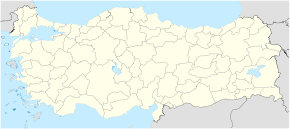- Monastery of the Miracles
-
Monastery of the Miracles
Սքանչելագործ վանք
Basic information Location  Van province, Armenian highland
Van province, Armenian highlandGeographic coordinates 38°54′29″N 42°42′10″E / 38.9080°N 42.7028°ECoordinates: 38°54′29″N 42°42′10″E / 38.9080°N 42.7028°E Affiliation Armenian Apostolic Church Region East Anatolia State Turkey Ecclesiastical or organizational status Destroyed by Turks in 1915 Status ceased functioning as a monastery in 1915 Architectural description Architectural type Armenian church Architectural style Armenian Completed 8th century Monastery of the Miracles (Armenian: Սքանչելագործ վանք) is a destroyed Armenian monastery on the hills in 2.18 miles northwest to the Adilcevaz city of Bitlis province of modern Turkey, to the north from the Lake Van.
History
It is believed that the earliest known mention of this monastery is from the second quarter of the 8th century when, according to the Acts of the Martyrs, Vahan of Goghthen stayed there. He was the son of a local Armenian ruler and had been taken by the Arabs to Syria and raised as a Muslim. He was later sent back to Armenia to govern his territory under Arab suzerainty. However, as soon as he arrived he renounced Islam, returned to Christianity, came to Artzque, and retired into a nearby hermitage called Erashkhavor. His abandonment of Islam would eventually lead to his martyrdom around the year 737. Erashkhavor, which means Monastery of the Protector, is probably an earlier name for Sk'anchelagortzi vank (Armenian prononciation to Monastery of the Miracles'). However, it is possible that Erashkhavor may have been another, now vanished, monastery that was also close to Artzque. The importance of the monastery arose from its possession of certain relics that were believed to have the power to cure disease. This accounts for its later name being Sk'anchelagortzi vank, the "Monastery of the Miracles". Until about the 14th century a relic known as the "Holy Emblem of War" affected these cures. After that time a second relic gradually superseded it. This new relic was a piece of a large bronze caldron that had been found, buried in the ground, by the monks during an epidemic of pestilence. It came to be believed that this was the basin in which Jesus had been washed in just after His birth. It is likely that what the monks had actually uncovered was part of an Urartian caldron. During the 14th, 15th, and 16th centuries the monastery housed a scriptorium - about 20 manuscripts have been identified as having being created there. At the end of the 19th century the monastery was still wealthy and owned much land. In 1893 an earthquake struck Artzque, destroying many houses. It is not know if the monastery was affected. In 1895 the monastery was attacked and robbed by Kurds, who also burned down the monastery's supplementary buildings. These were rebuilt at the start of the 20th century and the monastery continued to operate until Armenian Genocide in 1915.
- MONASTERY OF THE MIRACLES
Categories:- Armenian Churches in Turkey
- Christian monasteries established in the 8th century
- Destroyed landmarks
- Demolished buildings and structures in Turkey
Wikimedia Foundation. 2010.



